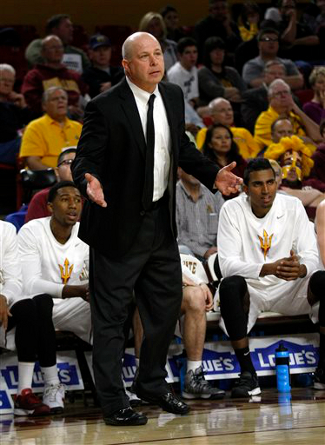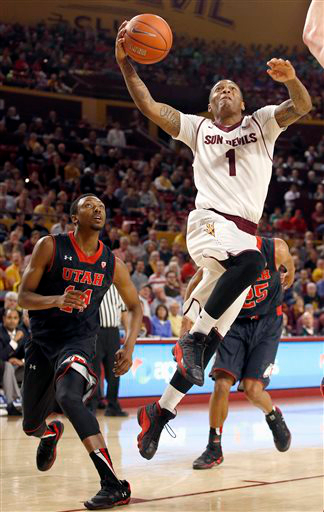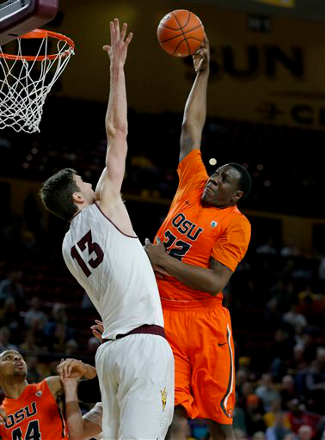Bradley Center | Milwaukee, WI | Tip: Approx. 8:40 P.M. CT | TV: CBS Vegas: Texas -1.5 | Pomeroy: Texas, 72-71 (53%) After fourteen consecutive years in the NCAA tournament, the Texas Longhorns stumbled through a disastrous 2012-13 campaign last season, ultimately flaming out in the first round of the CBI, Division I basketball’s third-tier postseason tournament. Predictions for this year’s team weren’t much better, with the Longhorns projected by the Big 12’s coaches to finish eighth out of ten teams. The media consensus was that head coach Rick Barnes was simply playing out the string, destined to have another mediocre or terrible season and earn his walking papers. Instead, a team made up of unheralded freshmen, sophomores who were formerly role players, and one quiet, junior leader have brought the Longhorns back to their familiar March home. Thanks to an early seven-game winning streak in the nation’s toughest conference, Texas didn’t even have to sweat the NCAA tournament bubble to earn their bid to this year’s tournament. Of course, overachieving also brings higher expectations. Now that the Longhorns are back in the tournament, the program’s recent NCAA history is once again part of the discussion. Since a 2008 run to the Elite Eight, the Longhorns have posted only a 2-4 mark in four trips to the Big Dance, and have failed to advance to the tournament’s second weekend. Although the Longhorn fanbase has been pleasantly surprised by this year’s team, another one-and-done visit to the NCAAs would be considered a failure.
Herb Sendek is concerned by his team’s recent slide By the numbers To avoid that fate, Texas will have to get through a stingy Arizona State team that plays stout defense and shoots the ball well from outside. Like the Longhorns, the Sun Devils have stumbled through the final few weeks of the season, and they are entering the NCAAs on a slide. ASU has lost their last three games and five of their last seven, a skid that came as a surprise on the heels of their exciting, double-overtime win against rival Arizona on Valentine’s Day. On the defensive end, the Sun Devils allow just 0.963 adjusted points per possession, the 33rd-best mark in Division I hoops. Arizona State does a good job limiting dribble penetration by playing tight on the perimeter, helping off the ball to clog driving lanes, and hedging hard on ball screens and recovering quickly. Inside, the presence of 7-foot, 2-inch shot-blocker extraordinaire Jordan Bachynski (No. 13) helps to clean up any drives that do happen to reach the paint. As a result, opponents take just 27.5% of their shots from long range and face a dilmena once they are inside the arc — take the higher-risk, low-reward midrange jumper, or force up a challenged look inside against a set defense with a gargantuan rim protector? On the other end of the court, the Sun Devils take more than enough threes to make up for the ones their opponents don’t take. ASU fires up 37.5% of their looks from behind the arc, and with a success rate of 38.6%, who can blame them? That makes them the 31st-most accurate three-point shooting team in NCAA Division I, and it keeps them in games despite not having an interior presence on the offensive end. Two ASU statistics that bode well for the Longhorns are their defensive turnover rate and their offensive rebounding numbers. During Texas’ late-season struggles, a spike in turnover rate helped to fuel blowouts at Kansas and Kansas State, and it put them in an early hole in a road loss to Iowa State. With the Sun Devils only forcing turnovers on 17.1% of opponents’ possessions, the Longhorns can hopefully avoid turnover woes tonight. Arizona State also only reclaims 24.2% of their missed shots, ranking them ahead of only 12 out of the 351 teams in Division I. In their loss to Stanford in the Pac-12 tournament, the Sun Devils won back just 6.5% of their missed shots! Against a Texas team that already posts excellent rebounding numbers on both ends of the court, those offensive rebounding struggles mean that the Sun Devils will have to make their threes if they want to advance to Saturday’s Round of 32.
Jahii Carson always finds his way to the rim Meet the Sun Devils Arizona State’s most well-known player is also its smallest, 5’10” point guard Jahii Carson (No. 1). A shifty sophomore who can slither through defenses with ease, Carson has already announced that he will be going pro following the season, setting the table for him to pump up his draft stock with a quality tournament run. Although Carson is fearless in attacking the rim and seems to do it on every possession, he is still incredibly accurate when he pops a three-pointer, making more than 39% of his looks. His aggressive penetration is also key in setting up teammates, with 29.1% of his teammate’s baskets when he’s on the court come as a result of his passes. Joining Carson in the backcourt is sharpshooter Jermaine Marshall (No. 34), a Penn State transfer who has made 40% of his threes on the year and averages more than 2.5 makes per game. Although Marshall is known for a quick release and deadly long-range accuracy, he can also take advantage of defenses that get up in his shirt by slashing to the rim. To say that Carson and Marshall fuel the Arizona State offense would be a considerable understatment. The pair has combined to play 80.6% of the team’s available minutes, with Carson taking 30.3% of the shots when he’s on the floor, and Marshall taking 26% of the shots when he’s on the court. Although there are other Sun Devils who can score against Texas tonight, a game plan that closely shadows Marshall and keeps Carson in front of the D would make things very, very difficult on ASU. On the wing, 6’5″ juco transfer Shaquielle McKissic (No. 40) is another driving threat, although he lacks the burst of Carson or the three-point threat of Marshall to keep defenses off-balance. Instead, McKissic has a craftier game, using good angles and spin moves to work his way towards the paint, while his great defensive instincts lead to quite a few easy, fast-break looks, as well. The fourth spot in the starting five has belonged to Eric Jacobsen (No. 3) for the final few weeks of the season, but his scant contributions in recent games have opened the door for Jonathan Gilling (No. 31) to reclaim his starting role. Jacobsen provides the team some size at 6’10”, but he is incredibly foul-prone and frequently turns the ball over. Against the Longhorns, Jacobsen might have to play extended minutes to match up against Jonathan Holmes, but after averaging just five minutes in the team’s last three games, it’s hard to see him making much of a contribution. The 6’7″ Gilling worked out with the starting group in yesterday’s open practice, and he gives the Sun Devils an offensive option that Jacobsen just cannot provide. Gilling is almost exlusively a long-range threat, having drilled 42.5% of his threes on the year. Three-point attempts make up 79% of his shots, and he needs very little time or space to one up, so Texas must stick to him like glue. If the Longhorns can keep him from getting daylight, Gilling’s inability to put the ball on the floor and make midrange jumpers would make him a non-factor.
Jordan Bachysnki frustrates opponents with his interior defense In the middle, Bachynski is a defensive presence that has frustrated opponents all season long. The Canadian product set the Pac-12’s all-time blocks record with seven games still left in his senior year, and he has posted the nation’s ninth-best block rate this year, swatting 12.7% of opponents’ two-point shots when he’s on the court. On the other end of the floor, Bachynski has a good hook shot over both shoulders when he’s isolated on the block, and he’s a monster target cutting to the rim on pick-and-rolls after the team’s frequent high ball screens. Off the bench, Bo Barnes (No. 4) is a three-point gunner who forced his way into the rotation when Marshall was struggling through a groin injury earlier this year. A local kid who started his college career at Hawaii, Barnes has made more than 40% of his threes this season and averaged more than 28 minutes in the team’s last three games. With a core rotation of seven players, depth is a major concern for Arizona State tonight. The Sun Devils also squeeze about 14 minutes per game out of 6’5″ Russian freshman Egor Koulechev (No. 15), but he has played just a total of seven minutes in the team’s last five contests. If foul trouble becomes a factor in this game, Coach Herb Sendek won’t find many options as he looks down the bench. Keys to the game 1) Attack inside – The Arizona State defense does a great job contracting and cutting off passing and driving lanes, so this is much easier said than done. However, if the Longhorns can pound the ball down low, they can not only attempt to exploit their size advantage, but also put Arizona State’s game-changer in foul trouble. If Bachynski is sidelined due to foul concerns, that Texas size advantage becomes even greater and interior points should be even more plentiful. 2) Push the pace – One glaring weakness in the Arizona State defense this season has been an inability to stop transition and the secondary break. UCLA and Utah are just two Pac-12 teams who exposed that deficiency this season, and Texas must aim to do the same thing tonight. The Longhorns need to look up after missed Sun Devil shots and quickly get as many people down the floor as they can. The Sun Devils don’t often turn the ball over, so Longhorn transition opportunities will have to come off of defensive rebounds. 3) Stick with the shooters – Texas’ interior defense and Arizona State’s preference for the long ball mean that the Longhorns don’t need to worry about giving up too many points in the paint. However, the Sun Devils can easily light it up from long range, and NCAA tournament history has shown that a key ingredient in a Round of 64 upset is hot three-point shooting. The Longhorns cannot afford to lose track of Marshall, Gilling, or Barnes, and they also have to keep up with Carson when he doesn’t have the ball. If Texas can keep Arizona State close to or below their season average behind the arc, the Horns should be able to advance to the next round. |












 1
1  2
2 